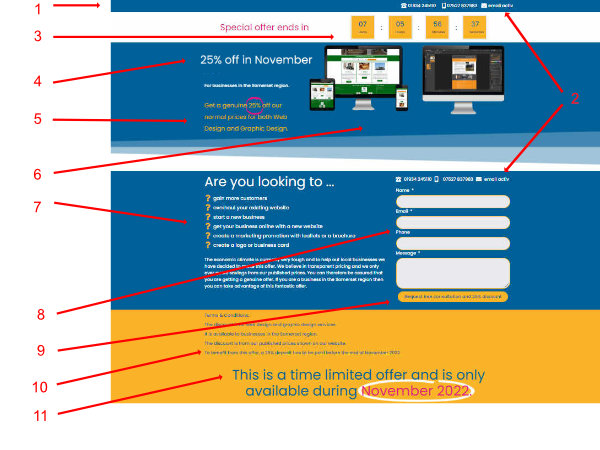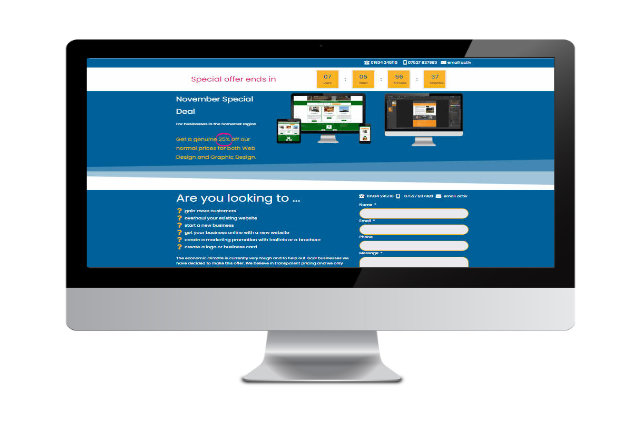Before going into the detail of a Landing Page, let’s start with a definition:
Landing Page definition
“A landing page is a standalone page on a website with a specific marketing aim of converting a visitor into a future customer.”
A landing page is part of an online marketing conversion campaign. Rather than direct visitors to a standard page on your website, it is far better to take them to a specifically created page related to whatever campaign you are running. The aim is for a visitor to ‘land’ on this page and for them to be sufficiently attracted by the offer you are making, for them to then either contact you or leave their details. This page can appear to a visitor as a result of an email campaign, search engine listing, online ad, or a link from elsewhere on your website. A landing page should be focussed on lead generation by giving something away in return for contact details. It could be a product or service offer, such as a discount, which could have a link to another page or it could have a call to action (CTA) button to enable the visitor to leave their contact details and receive the offer.
A landing page is one component of what is called ‘Website conversion’. A full description of this is covered in this recent article ‘What is website conversion and why it is really important for your business‘.
“A conversion on a website is when a visitor takes the action specified on the webpage. This could be, for example, completing a lead capture form, or purchasing a product. “
Why is a landing page different from other pages on your website?
This page has a very specific purpose and that is to capture leads or sell something. It will not have any navigation (that might distract and tempt visitors away) but will have strong sales copy that will summarise the benefits of the offer and it will have a call to action.
Why should you have a landing page?
Landing pages provide a focussed area on your website to promote a specific offer. As a result, they provide a far easier way to generate leads for a business. Combined with analytics, they can also provide useful metrics which will provide marketing insights into the type of visitor and their website behaviours, and you can also use the data to compare the effectiveness of different landing page campaigns.
What should a landing page contain?
The page is there to capture contact details, so it should have a short contact form together with all the appropriate contact details such as phone numbers and email address. It needs to clearly define the offer, whether you are offering something in exchange for a visitor's details, or whether you are promoting an offer on a product or service. Importantly it needs to clearly define what you want a visitor to do. In most cases, having an image of what you are offering will help in the conversion process.
What makes a good landing page?
By ‘good’ we mean a page that converts a visitor into someone who makes an enquiry via a form or call or email and then has the potential to become a customer or purchase a product/service from the page. The following list covers the minimum factors to consider for a good landing page. Each item is referenced in the landing page diagram below.
- 1. Standalone page without normal website navigation
- 2. Contact details such as phone and email
- 3. If you have a time-limited offer, a countdown timer can be useful to focus the attention of a visitor
- 4. A clear and attention-grabbing headline
- 5. Expand on your headline and clarify the offer. This needs to be powerful and engaging to keep a visitor on the page
- 6. Add some images that relate to your offering
- 7. Add additional information about the offer and include what could be pain points for the visitor
- 8. Contact form/lead capture. Keep the amount of requested information to a minimum and make sure the CTA button is descriptive and not just ‘send’
- 9. CTA button describing the action you want the visitor to take and the offer available
- 10. Add T&Cs if relevant but also if it helps to answer any objection handling
- 11. If you have a time-limited offer it is useful to highlight this again at the end of the landing page

Example landing page with key components identified.
Whilst you do not want to overwhelm visitors with too much content, it is worth considering adding such things as social proof, which could be testimonials or awards, or any press coverage you have had. Also, adding social share buttons allows visitors to spread the word about the offer you are promoting.
Why do more businesses not use landing pages?
A lot of businesses do not know what a landing page is and do not realise the marketing benefits it can bring. It is also true that a lot of businesses do not know how to design the layout and then actually set them up.
It is important to remember that a landing page is the start of hopefully a successful business relationship with your new lead. Depending on what your offer was, you may still have to guide them through the sales funnel, so make sure you follow up and start to build that all-important relationship.
If you would like to find out more about how landing pages can have a big impact on lead generation for your company, please get in touch for a free consultation.


